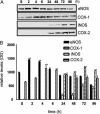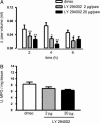Endothelial nitric oxide synthase activation is critical for vascular leakage during acute inflammation in vivo
- PMID: 15640348
- PMCID: PMC545512
- DOI: 10.1073/pnas.0408906102
Endothelial nitric oxide synthase activation is critical for vascular leakage during acute inflammation in vivo
Abstract
The role of endothelium-derived nitric oxide (NO) in acute inflammation is not known. Here, we examine acute inflammation in congenic endothelial NO synthase-deficient (eNOS-/-) mice. Intraplantar injection of carrageenan induces a biphasic inflammatory response. The early phase (0-6 h) is largely eliminated, and the secondary phase (24-96 h) is markedly reduced in eNOS-/- but not WT mice. Inhibition of phosphatidylinositol 3-kinase or hsp90, pathways upstream of eNOS activation, also reduces carrageenan-stimulated edema formation. To separate the ability of eNOS to regulate leukocyte trafficking vs. vascular permeability, zymosan-stimulated leukocyte infiltration and protein extravasation were assessed in WT and eNOS-/- mice. Zymosan increases inflammatory cell extravasation to the same extent in WT and eNOS-/- mice, whereas the extravasation of plasma protein is lower in eNOS-/- mice. Inhibition of phosphatidylinositol 3-kinase and hsp90 also blocks protein leakage, but not leukocyte influx. These data collectively support the critical role for eNOS in regulating the magnitude of the acute inflammatory response and show that eNOS is critical for regulating microcirculatory endothelial barrier function in vivo.
Figures





References
-
- Cirino, G., Fiorucci, S. & Sessa, W. C. (2003) Trends Pharmacol. Sci. 24, 91-95. - PubMed
-
- Sessa, W. C. (1994) J. Vasc. Res. 31, 131-143. - PubMed
-
- He, P., Liu, B. & Curry, F. E. (1997) Am. J. Physiol. 272, H176-H185. - PubMed
-
- Lal, B. K., Varma, S., Pappas, P. J., Hobson II, R. W. & Duran, W. N. (2001) Microvasc. Res. 62, 252-262. - PubMed
MeSH terms
Substances
LinkOut - more resources
Full Text Sources
Other Literature Sources
Molecular Biology Databases

